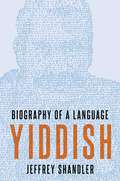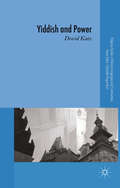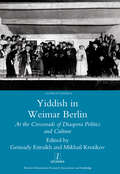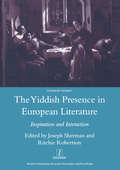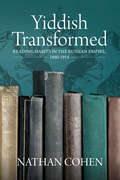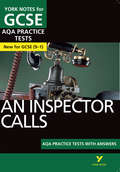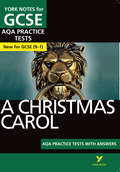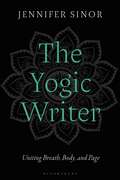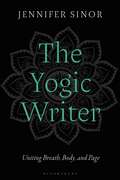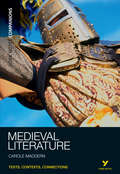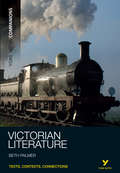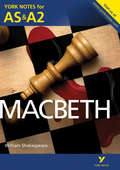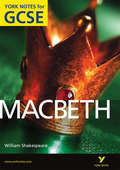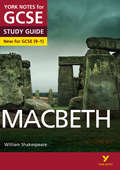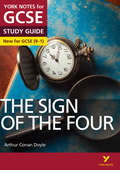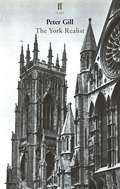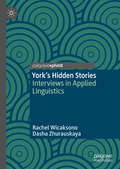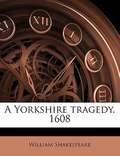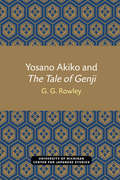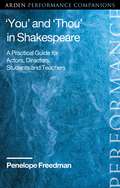- Table View
- List View
Yiddish: Biography of a Language
by Jeffrey ShandlerThe most widely spoken Jewish language on the eve of the Holocaust, Yiddish continues to play a significant role in Jewish life today, from Hasidim for whom it is a language of daily life to avant-garde performers, political activists, and LGBTQ writers turning to Yiddish for inspiration. Yiddish: Biography of a Language presents the story of this centuries-old language, the defining vernacular of Ashkenazi Jews, from its origins to the present. Jeffrey Shandler tells the multifaceted history of Yiddish in the form of a biographical profile, revealing surprising insights through a series of thematic chapters. He addresses key aspects of Yiddish as the language of a diasporic population, whose speakers have always used more than one language. As the vernacular of a marginalized minority, Yiddish has often been held in low regard compared to other languages, and its legitimacy as a language has been questioned. But some devoted Yiddish speakers have championed the language as embodying the essence of Jewish culture and a defining feature of a Jewish national identity. Despite predictions of the demise of Yiddish-dating back well before half of its speakers were murdered during the Holocaust-the language leads a vibrant, evolving life to this day.
Yiddish and Power: Ten Overhauls Of A Stateless Language (Palgrave Studies in Minority Languages and Communities)
by D. KatzYiddish and Power surveys the social, linguistic and intellectual history of the Yiddish language within the traditional civilisation of Jewish Ashkenaz in central, and then in eastern Europe, and its interaction with the surrounding non-Jewish culture. It explores the various ways in which Yiddish has empowered masses and served political agendas.
Yiddish in Weimar Berlin: At the Crossroads of Diaspora Politics and Culture
by Gennady Estraikh"Berlin emerged from the First World War as a multicultural European capital of immigration from the former Russian Empire, and while many Russian emigres moved to France and other countries in the 1920s, a thriving east European Jewish community remained. Yiddish-speaking intellectuals and activists participated vigorously in German cultural and political debate. Multilingual Jewish journalists, writers, actors and artists, invigorated by the creative atmosphere of the city, formed an environment which facilitated exchange between the main centres of Yiddish culture: eastern Europe, North America and Soviet Russia. All this came to an end with the Nazi rise to power in 1933, but Berlin remained a vital presence in Jewish cultural memory, as is testified by the works of Sholem Asch, Israel Joshua Singer, Zalman Shneour, Moyshe Kulbak, Uri Zvi Grinberg and Meir Wiener. This volume includes contributions by an international team of leading scholars dealing with various aspects of history, arts and literature, which tell the dramatic story of Yiddish cultural life in Weimar Berlin as a case study in the modern European culture."
Yiddish in Weimar Berlin: At the Crossroads of Diaspora Politics and Culture
by Gennady Estraikh"Berlin emerged from the First World War as a multicultural European capital of immigration from the former Russian Empire, and while many Russian emigres moved to France and other countries in the 1920s, a thriving east European Jewish community remained. Yiddish-speaking intellectuals and activists participated vigorously in German cultural and political debate. Multilingual Jewish journalists, writers, actors and artists, invigorated by the creative atmosphere of the city, formed an environment which facilitated exchange between the main centres of Yiddish culture: eastern Europe, North America and Soviet Russia. All this came to an end with the Nazi rise to power in 1933, but Berlin remained a vital presence in Jewish cultural memory, as is testified by the works of Sholem Asch, Israel Joshua Singer, Zalman Shneour, Moyshe Kulbak, Uri Zvi Grinberg and Meir Wiener. This volume includes contributions by an international team of leading scholars dealing with various aspects of history, arts and literature, which tell the dramatic story of Yiddish cultural life in Weimar Berlin as a case study in the modern European culture."
The Yiddish Presence in European Literature: Inspiration and Interaction: Selected Papers Arising from the Fourth and Fifth International Mendel Friedman Conference
by Joseph Sherman"Early in the twentieth century, Yiddish, previously stigmatized as a corrupt jargon, came to be recognized as a language in its own right, and one moreover that was already the vehicle for a rich literature. Many writers in other European languages steadily became aware of the status and richness of the Yiddish language, sometimes by encountering Yiddish-speaking communities in Eastern Europe, and they responded to Yiddish language and culture in their own works, while Yiddish writers adopted, and sometimes anticipated, modern trends in other European literatures known to them. The collection of papers in this volume examines some of these fruitful interactions between Yiddish and the European literary tradition, ranging from the early nineteenth century to the present, from France to Lithuania, and from classic modernist writers such as Kafka to Imre Kertesz (Nobel Prize for Literature, 2002). With the contributions: Gilles Rozier- 'When Purim-shpiler meets Columbine': Characters of Commedia dell'arte and Purimshpil in the Works of Moyshe Broderzon David Bellos- In the Worst Possible Taste: Romain Gary's Dance of Genghis Cohn Florian Krobb- 'Muthwillige Faschingstracht': The Presence of Yiddish in Nineteenth-Century German Literature Ritchie Robertson- Kafka's Encounter with the Yiddish Theatre David Groiser- Translating Yiddish: Martin Buber and David Pinski Mikhail Krutikov- Yiddish Author as Cultural Mediator: Meir Wiener's Unpublished Novel David Midgley- The Romance of the East: Encounters of German-Jewish Writers with Yiddish-Speaking Communities, 1916-27 PolO Dochartaigh - Intimacy and Alienation: Yiddish in the Works of Jurek Becker Peter Sherwood- 'Living through Something': Notes on the Work of Imre Kertesz Joseph Sherman- Bergelson and Chekhov: Convergences and Departures Gennady Estraikh- Shmuel Gordon: A Yiddish Writer in 'the Ocean of Russian Literature'"
The Yiddish Presence in European Literature: Inspiration and Interaction: Selected Papers Arising from the Fourth and Fifth International Mendel Friedman Conference
by Joseph Sherman"Early in the twentieth century, Yiddish, previously stigmatized as a corrupt jargon, came to be recognized as a language in its own right, and one moreover that was already the vehicle for a rich literature. Many writers in other European languages steadily became aware of the status and richness of the Yiddish language, sometimes by encountering Yiddish-speaking communities in Eastern Europe, and they responded to Yiddish language and culture in their own works, while Yiddish writers adopted, and sometimes anticipated, modern trends in other European literatures known to them. The collection of papers in this volume examines some of these fruitful interactions between Yiddish and the European literary tradition, ranging from the early nineteenth century to the present, from France to Lithuania, and from classic modernist writers such as Kafka to Imre Kertesz (Nobel Prize for Literature, 2002). With the contributions: Gilles Rozier- 'When Purim-shpiler meets Columbine': Characters of Commedia dell'arte and Purimshpil in the Works of Moyshe Broderzon David Bellos- In the Worst Possible Taste: Romain Gary's Dance of Genghis Cohn Florian Krobb- 'Muthwillige Faschingstracht': The Presence of Yiddish in Nineteenth-Century German Literature Ritchie Robertson- Kafka's Encounter with the Yiddish Theatre David Groiser- Translating Yiddish: Martin Buber and David Pinski Mikhail Krutikov- Yiddish Author as Cultural Mediator: Meir Wiener's Unpublished Novel David Midgley- The Romance of the East: Encounters of German-Jewish Writers with Yiddish-Speaking Communities, 1916-27 PolO Dochartaigh - Intimacy and Alienation: Yiddish in the Works of Jurek Becker Peter Sherwood- 'Living through Something': Notes on the Work of Imre Kertesz Joseph Sherman- Bergelson and Chekhov: Convergences and Departures Gennady Estraikh- Shmuel Gordon: A Yiddish Writer in 'the Ocean of Russian Literature'"
Yiddish Transformed: Reading Habits in the Russian Empire, 1860-1914
by Nathan CohenAs significant economic, social, political, and cultural transformations swept the Jewish population of Tsarist Russia and Congress Poland between 1860 and 1914, the Yiddish language (Zhargon) began to gain recognition as a central part of the Jewish cultural stage. Yiddish Transformed examines the secular reading habits of East-European Jews as the Jewish community began shifting to a modern society. Author Nathan Cohen explores Jewish reading practices alongside the rise of Yiddish by delving into publishing policies of Yiddish books and newspapers, popular literary genres of the time, the development of Jewish public libraries, as well as personal reflections of reading experiences.
Yiddish Transformed: Reading Habits in the Russian Empire, 1860-1914
by Nathan CohenAs significant economic, social, political, and cultural transformations swept the Jewish population of Tsarist Russia and Congress Poland between 1860 and 1914, the Yiddish language (Zhargon) began to gain recognition as a central part of the Jewish cultural stage. Yiddish Transformed examines the secular reading habits of East-European Jews as the Jewish community began shifting to a modern society. Author Nathan Cohen explores Jewish reading practices alongside the rise of Yiddish by delving into publishing policies of Yiddish books and newspapers, popular literary genres of the time, the development of Jewish public libraries, as well as personal reflections of reading experiences.
Yiddish Transformed: Reading Habits in the Russian Empire, 1860-1914
by Nathan CohenAs significant economic, social, political, and cultural transformations swept the Jewish population of Tsarist Russia and Congress Poland between 1860 and 1914, the Yiddish language (Zhargon) began to gain recognition as a central part of the Jewish cultural stage. Yiddish Transformed examines the secular reading habits of East-European Jews as the Jewish community began shifting to a modern society. Author Nathan Cohen explores Jewish reading practices alongside the rise of Yiddish by delving into publishing policies of Yiddish books and newspapers, popular literary genres of the time, the development of Jewish public libraries, as well as personal reflections of reading experiences.
Yna5 Aic Gcse Lit Practice Tests: - the best way to practise and feel ready for 2022 and 2023 assessments and exams (York Notes)
by Jo HeathcoteLearn - With seven practice tests to work through, you'll get to grips with exam-style questions and the skills examiners are looking for. Use the write-in space to plan and write mark-maximising answers. Practise - Test yourself using the annotated sample answers and see your abilities grow. Feel proud of your progress as you put your knowledge to the test, perfect your skills and start getting more answers right more often. Pass - With York Notes Practice Tests, you can go into your exams feeling confident about writing your best possible responses.
Yna5 Cc Gcse Lit Practice Tests: - the best way to practise and feel ready for 2022 and 2023 assessments and exams (York Notes)
by Beth KempLearn - With seven practice tests to work through, you'll get to grips with exam-style questions and the skills examiners are looking for. Use the write-in space to plan and write mark-maximising answers. Practise - Test yourself using the annotated sample answers and see your abilities grow. Feel proud of your progress as you put your knowledge to the test, perfect your skills and start getting more answers right more often. Pass - With York Notes Practice Tests, you can go into your exams feeling confident about writing your best possible responses.
The Yogic Writer: Uniting Breath, Body, and Page
by Dr Jennifer SinorFusing the craft of writing with the philosophy of yoga, The Yogic Writer charts a path to the heart of creativity through the practice of yogic breathing, somatic exercises, and meditations. In response to an oftentimes paralyzing focus on outcome and product, Jennifer Sinor summons decades of experience teaching creative writing and yoga to guide our attention back to the body, the place from which all art arises.When invested with deep awareness, writing transforms us as human beings. The Yogic Writer connects the recursive process of writing – creating space for intentions, drafting, revision, and sitting in sites of possibility and potential – with the four stages of breath. Through brief insightful essays, Sinor meets writers in the present moment, providing craft advice while challenging us to explore how we look, who is really writing, and how to listen to our bodies. Steeped in ideas owed to ancient wisdom as well as creative writing pedagogy and Sinor's own experience, The Yogic Writer offers a unique, alternative approach to finding creativity that forsakes external validation for internal knowledge and experimentation. Inspirational, affirmational, and personal, this book is for anyone seeking permission to embody the life of a writer that they already know, deep down, to be theirs.
The Yogic Writer: Uniting Breath, Body, and Page
by Dr Jennifer SinorFusing the craft of writing with the philosophy of yoga, The Yogic Writer charts a path to the heart of creativity through the practice of yogic breathing, somatic exercises, and meditations. In response to an oftentimes paralyzing focus on outcome and product, Jennifer Sinor summons decades of experience teaching creative writing and yoga to guide our attention back to the body, the place from which all art arises.When invested with deep awareness, writing transforms us as human beings. The Yogic Writer connects the recursive process of writing – creating space for intentions, drafting, revision, and sitting in sites of possibility and potential – with the four stages of breath. Through brief insightful essays, Sinor meets writers in the present moment, providing craft advice while challenging us to explore how we look, who is really writing, and how to listen to our bodies. Steeped in ideas owed to ancient wisdom as well as creative writing pedagogy and Sinor's own experience, The Yogic Writer offers a unique, alternative approach to finding creativity that forsakes external validation for internal knowledge and experimentation. Inspirational, affirmational, and personal, this book is for anyone seeking permission to embody the life of a writer that they already know, deep down, to be theirs.
York Notes Companions: Medieval Literature
by Dr Carole MaddernThis volume spans five centuries of post-Conquest literature, written at a time in which enormous social, political and linguistic changes transformed life in Britain. Medieval genres such as Arthurian romance, lyrics, dream narratives and mystery plays are brought to life and accompanied by discussions of key debates such as "Gender and Power", "The Emergent Individual" and "Society and Class". Bringing together historical contexts and critical theory, this is essential reading for any student of medieval literature.
York Notes Companions: Victorian Literature (York Notes Companions Ser.)
by Dr Beth PalmerAn accessible and wide-ranging introduction to the era, this companion explores influential dramatic works by Ibsen, Shaw and Wilde; the poetry of mourning; novelistic genres, including social problem novels and sensation fiction; and the literature of the fin de siècle's aesthetes and decadents. Cultural and historical debates - focussing on empire, national identity, science and evolution, print culture and gender - supply essential context alongside discussion of relevant critical theory.
York Notes for AS and A2: Macbeth (York Notes)
by Alisdair MacraeTHE ULTIMATE GUIDES TO EXAM SUCCESS from York Notes - the UK's favourite English Literature Study Guides. York Notes for AS & A2 are brand new and have been specifically designed to help AS and A2 studnets to get the very best grade you can. They are comprehensive, easy to use, packed with valuable features and written by experienced examiners and teachers to give you an expert understanding of the text, critical approaches and the all-important exam. This edition covers Macbeth and includes: An enhanced exam skills section which includes essay plans, expert guidance on understanding questions and sample answers. You’ll know exactly what you need to do and say to get the best grades. A wealth of useful content like key quotations, revision tasks and vital study tips that’ll help you revise, remember and recall all the most important information. The widest coverage and the best, most in-depth analysis of characters, themes, language, form, context and style to help you demonstrate an exhaustive understanding of all aspects of the text. York Notes for AS & A2 are also available for these popular titles: The Bloody Chamber(9781447913153)Doctor Faustus(9781447913177)Frankenstein (9781447913214)The Great Gatsby(9781447913207)The Kite Runner(9781447913160)Othello(9781447913191)WutheringHeights(9781447913184)
York Notes for GCSE: Macbeth (York Notes)
by James SaleNEW FOR 2011Everything you need to know and do to get the grade you want!Now in full colour, updated for the new GCSE and available in a new, student-friendly size, York Notes for GCSE is now easier to use and easier to read, so it's easier than ever to get top marks.Written by examiners and teachers to give you an expert understanding of the text, York Notes has the most in-depth coverage and analysis of everything from themes and contexts to characters, plots and language. You'll get the low-down on everything you'll need to demonstrate how well you understand the text and write the best essays.There are sample answers, essay plans and specialist guidance on understanding the questions you'll be asked in an exam, together with an array of handy quotes, checklists, study tips, grade boosters and revision activities to help you learn, revise efficiently and remember everything you'll need to write the very best answers. It's the ultimate guide to revision and exam success.For over 25 years, York Notes has been helping GCSE students just like you achieve the very best grade they can in their exam. So if you're looking for straightforward, easy-to-use advice on how to boost your grades to the next level, York Notes for GCSE is the only guide you're going to need.
York Notes for GCSE: Macbeth (York Notes)
by James Sale Ms Alison PowellA fully revised exam section: expert guidance on understanding the question, planning an answer, writing about effects and using quotations, plus tips on spelling, punctuation and grammar. All the key skills covered: ‘Exam focus’ model answer extracts with annotations, and ‘Progress and Revision Checks’ will guide students’ learning, help them test their progress and reach their potential. The most in-depth analysis: from text summaries to characters, themes, contexts, form, structure and language, all designed to help students reach their potential.
York Notes for GCSE (9-1), Study Guide: The Sign of the Four
by Ms Jo HeathcoteA fully revised exam section: expert guidance on understanding the question, planning an answer, writing about effects and using quotations, plus tips on spelling, punctuation and grammar. All the key skills covered: ‘Exam focus’ model answer extracts with annotations, and ‘Progress and Revision Checks’ will guide your learning, help you test your progress and reach your potential. The most in-depth analysis: from text summaries to characters, themes, contexts, form, structure and language, all designed to help you to succeed.
York Realist, The: Cardiff East, Certain Young Men, The York Realist, Original Sin
by Peter GillEarly 1960s, Yorkshire. Farm labourer George is cast in an amateur staging of the York Mystery Plays. His world is shaken when he falls for metropolitan assistant director John and the two men embark on a clandestine affair.Peter Gill's influential play is not only a finely drawn love story; it is also a touching reflection on the rival forces of family, class, and the origins and ownership of art.The York Realist was premiered by the English Touring Theatre at The Lowry, Salford Quays in November 2001; it moved to the Bristol Old Vic that same year and, in 2002, to the Royal Court Theatre, London. The play was revived by the Donmar Warehouse, London, in February 2018.Winner of the London Critics' Circle Award for Best New Play.'As a love story, The York Realist is riveting and heart-rendering... Gill is always terrifically perceptive about male tenderness. The personal and political are subtly united in a study of English masculinity, class and culture. Such outstanding work.' Independent on Sunday'Sensationally fine and poignant.' Evening Standard'It has the Lawrentian qualities of emotional intelligence, raw honesty and fascination with the intersection of class and sex... It is about the way the English, however hard they try, can never finally escape their origins. But, far from being emotionally conservative, it is adventurous, witty and fresh... The play comes like a rare blast of reality.' Guardian
York's Hidden Stories: Interviews in Applied Linguistics
by Rachel Wicaksono Dasha ZhurauskayaThis book explores the mechanics of storytelling within a study aimed at focusing on a ‘hidden’ population of migrants in the city of York, UK. Taking applied linguistics to mean the consideration of real-world ‘problems’ as identified by a ‘client’, in which the use of (and beliefs about) language is a significant component, the authors describe the benefits and challenges of working in a partnership with a community organisation. With project participants from Africa, Europe, Asia and South and Central America who had lived in York between two and fifty years, the study considers the co-construction of meaning in interviews from a range of practical and theoretical perspectives. The book will be of interest to students, academic researchers and community project leaders who are interested in migration stories and interviews as a method of data collection.
A Yorkshire Tragedy
by ShakespeareThe plot of the play is based on the biographical account of Walter Calverley of Calverley Hall, Yorkshire, who was executed on 5 August 1605 for murdering two of his children and stabbing his wife. <P> <P> The crimes were a well-known scandal of the day; a pamphlet on the case was issued in June 1605, with a ballad following in July. The chronicler John Stow reported the case in his Annals.[1][2] The murders were also dramatised in a play titled The Miseries of Enforced Marriage (1607), by George Wilkins. Scholars have disagreed on the relationship between Wilkins's play and A Yorkshire Tragedy; some of have seen one play as a source for the other, or even the work of the same author, while others regard the two dramas as essentially separate works.[3]
Yosano Akiko and The Tale of Genji (Michigan Monograph Series in Japanese Studies #28)
by Gaye Rowley G. G. RowleyYosano Akiko (1878–1942) has long been recognized as one of the most important literary figures of prewar Japan. Her renown derives principally from the passion of her early poetry and from her contributions to 20th-century debates about women. This emphasis obscures a major part of her career, which was devoted to work on the Japanese classics and, in particular, the great Heian period text The Tale of Genji. Akiko herself felt that Genji was the bedrock upon which her entire literary career was built, and her bibliography shows a steadily increasing amount of time devoted to projects related to the tale. This study traces for the first time the full range of Akiko’s involvement with The Tale of Genji. The Tale of Genji provided Akiko with her conception of herself as a writer and inspired many of her most significant literary projects. She, in turn, refurbished the tale as a modern novel, pioneered some of the most promising avenues of modern academic research on Genji, and, to a great extent, gave the text the prominence it now enjoys as a translated classic. Through Akiko’s work Genji became, in fact as well as in name, an exemplum of that most modern of literary genres, the novel. In delineating this important aspect of Akiko’s life and her bibliography, this study aims to show that facile descriptions of Akiko as a “poetess of passion” or “new woman” will no longer suffice.
‘You’ and ‘Thou’ in Shakespeare: A Practical Guide for Actors, Directors, Students and Teachers (Arden Performance Companions)
by Penelope FreedmanRomeo and Juliet always use 'thou' to each other, but they are the only pair of lovers in Shakespeare to do this. Why? All the women in Richard III address Richard as 'thou', but no man ever does. Why? When characters address the dead, they use 'thou' – except for Hamlet, who addresses Yorick as 'you'. Why? Shakespeare's contemporaries would have known the answers to these questions because they understood what 'thou' signified, but modern actors and audiences are in the dark. Through performance-oriented analysis of extracts from the plays, this book explores the language of 'trulls' and termagants, true loves and unwelcome wooers, male impersonators, smothering mothers, warring spouses and fighting men, as well as investigating lèse-majesté, Freudian slips, crisis moments and rhetorical flourishes. Drawing on work with RSC actors, as well as the author's experience of playing a range of Shakespearean roles, the book equips the reader with a new tool for tracking emotions, weighing power relations and appreciating dazzling complexity.
‘You’ and ‘Thou’ in Shakespeare: A Practical Guide for Actors, Directors, Students and Teachers (Arden Performance Companions)
by Penelope FreedmanRomeo and Juliet always use 'thou' to each other, but they are the only pair of lovers in Shakespeare to do this. Why? All the women in Richard III address Richard as 'thou', but no man ever does. Why? When characters address the dead, they use 'thou' – except for Hamlet, who addresses Yorick as 'you'. Why? Shakespeare's contemporaries would have known the answers to these questions because they understood what 'thou' signified, but modern actors and audiences are in the dark. Through performance-oriented analysis of extracts from the plays, this book explores the language of 'trulls' and termagants, true loves and unwelcome wooers, male impersonators, smothering mothers, warring spouses and fighting men, as well as investigating lèse-majesté, Freudian slips, crisis moments and rhetorical flourishes. Drawing on work with RSC actors, as well as the author's experience of playing a range of Shakespearean roles, the book equips the reader with a new tool for tracking emotions, weighing power relations and appreciating dazzling complexity.
